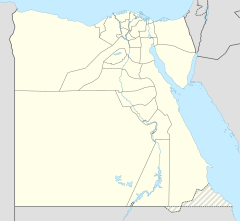Amir Qijmas al-Ishaqi Mosque
| Amir Qijmas al-Ishaqi Mosque مسجد قجماس الإسحاقي | |
|---|---|
 | |
| Religion | |
| Affiliation | Islam |
| Region | Africa |
| Status | Active |
| Location | |
| Location | Cairo, Egypt |
| Geographic coordinates | 30°02′29″N 31°15′27″E / 30.0414302°N 31.257432°E |
| Architecture | |
| Type | Mosque |
| Style | Islamic |
| Completed | 1480-1481 |
Amir Qijmas al-Ishaqi Mosque (Template:Lang-ar) or Abu Heriba Mosque (Template:Lang-ar) is a historic mosque in Cairo. It is located in El-Darb El-Ahmar district, near Bab Zuweila of the Muizz Street.[1]
Description
It was completed in 1480-1481, and commissioned by the Burji Mamluk Emir Qijmas al-Ishaqi who served during the rule of Sultan Qaitbay. The nickname "Abu Heriba" is derived from Sheikh Abu Heriba who was known as a wali and was buried under the dome of the mosque in 1852.[2][3] The mosque is known for being featured on the 50 Egyptian pound bill. It is also distinguishable from other mosques in the way it allows the shops to rent and operate on the first floor, thus be able to fund the maintenance cost from them.[1]
Architecture

The side which faces the El-Darb El-Ahmar Street contains the mausoleum, iwan, sabil and a dome. It was designed by the architect in order to match the urban planning of the roads and to not impede the pedestrian ways. In order to do so, certain parts of the mosque such as the faucet, hamam, water tank and the library were separated on the other side of the narrow alley, thus overlooking the main facility and connected by the high pass with the main building.[1]
The interior contains a sahn in the middle and four iwans surrounding it. Mihrab adorned with marbles exists on the southeastern qibla iwan. The mihrab is enclosed with columns reaching five meters, and it is decorated with the Qur'anic verses inscribed in Kufi script. The wooden minbar in front of the mihrab is decorated with stellar plates and ivory. Floor of the mosque is furnished with marble as well. The minaret exists on the left side of the main entrance.[1][2]
Condition
Al Wafd newspaper criticized the condition of the mosque as resulting from the negligence on the part of the Ministry of the Antiquity. According to the paper, the main facade is deteriorated and the surrounding is filled with garbage piles.[4]
Gallery
-
Mihrab and minbar
-
Ceiling
-
Window frame
References
- ^ a b c d بالصور: مسجد قجماس الأسحاقي الشهير بـ"أبو حريبة" وجامع الخمسين جنيه. Masrawy. Retrieved January 12, 2018.
- ^ a b مسجد قجماس الإسحاقى.. شهرته «أبو حريبة».. براعة معمارية تاريخها 177 عاما.. إيوانات مزخرفة.. أسقف ملونة.. كتابات قرآنية بالخط الكوفى.. فيديو وصور. El Balad. Retrieved January 12, 2018.
- ^ Masjid Amir Qijmas al-Ishaqi. Archnet. Retrieved January 12, 2018.
- ^ بالصور.. مسجد "قجماس الإسحاقي" كرمته الدولة وأهملته وزارة الآثار. Al Wafd. Retrieved January 12, 2018.
Bibliography
- Behrens-Abouseif, Doris. Islamic Architecture in Cairo. Leiden: E. J. Brill, 1989.
- Jarrar, Sabri, András Riedlmayer, and Jeffrey B. Spurr. Resources for the Study of Islamic Architecture. Cambridge, MA: Aga Khan Program for Islamic Architecture, 1994.





